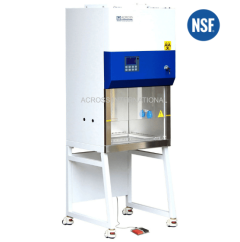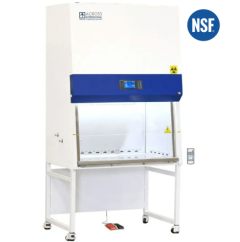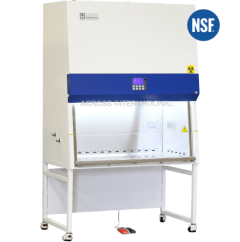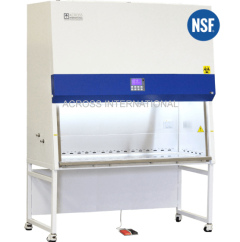We use cookies to make your experience better. To comply with the new e-Privacy directive, we need to ask for your consent to set the cookies. Learn more.
A biosafety cabinet also called a biological safety cabinet or microbiological safety cabinet is an enclosed, ventilated laboratory workspace for safely working with materials contaminated with (or potentially contaminated with) pathogens requiring a defined biosafety level.
The primary purpose of a BSC is to serve as a means to protect the laboratory worker and the surrounding environment from pathogens. All exhaust air is HEPA-filtered as it exits the biosafety cabinet, removing harmful bacteria and viruses. This is in contrast to a laminar flow clean bench, which blows unfiltered exhaust air towards the user and is not safe for work with pathogenic agents. Neither are most BSCs safe for use as fume hoods. Likewise, a fume hood fails to provide the environmental protection that HEPA filtration in a BSC would provide. However, most classes of BSCs have a secondary purpose to maintain the sterility of materials inside (the "product").
Class Icabinets provide personnel and environmental protection but no product protection. In fact, the inward flow of air can contribute to contamination of samples. Inward airflow is maintained at a minimum velocity of 75 ft/min(0.38 m/s). These BSCs are commonly used to enclose specific equipment (e.g. centrifuges) or procedures (e.g. aerating cultures) that potentially generate aerosols. BSCs of this class are either ducted (connected to the building exhaust system) or unducted (recirculating filtered exhaust back into the laboratory.
Class II cabinets provide both kinds of protection (of the samples and of the environment) since makeup air is also HEPA-filtered. There are five types: Type A1 (formerly A), Type A2 (formerly A/B3), Type B1, Type B2 and Type C1. Each type's requirements are defined by NSF International Standard 49, which in 2002 reclassified A/B3 cabinets (classified under the latter type if connected to an exhaust duct) as Type A2, and added the Type C1 in the 2016 standard. About 90% of all biosafety cabinets installed are Type A2 cabinets.
Biosafety Cabinets
A biosafety cabinet also called a biological safety cabinet or microbiological safety cabinet is an enclosed, ventilated laboratory workspace for safely working with materials contaminated with (or potentially contaminated with) pathogens requiring a defined biosafety level.
The primary purpose of a BSC is to serve as a means to protect the laboratory worker and the surrounding environment from pathogens. All exhaust air is HEPA-filtered as it exits the biosafety cabinet, removing harmful bacteria and viruses. This is in contrast to a laminar flow clean bench, which blows unfiltered exhaust air towards the user and is not safe for work with pathogenic agents. Neither are most BSCs safe for use as fume hoods. Likewise, a fume hood fails to provide the environmental protection that HEPA filtration in a BSC would provide. However, most classes of BSCs have a secondary purpose to maintain the sterility of materials inside (the "product").
Class Icabinets provide personnel and environmental protection but no product protection. In fact, the inward flow of air can contribute to contamination of samples. Inward airflow is maintained at a minimum velocity of 75 ft/min(0.38 m/s). These BSCs are commonly used to enclose specific equipment (e.g. centrifuges) or procedures (e.g. aerating cultures) that potentially generate aerosols. BSCs of this class are either ducted (connected to the building exhaust system) or unducted (recirculating filtered exhaust back into the laboratory.
Class II cabinets provide both kinds of protection (of the samples and of the environment) since makeup air is also HEPA-filtered. There are five types: Type A1 (formerly A), Type A2 (formerly A/B3), Type B1, Type B2 and Type C1. Each type's requirements are defined by NSF International Standard 49, which in 2002 reclassified A/B3 cabinets (classified under the latter type if connected to an exhaust duct) as Type A2, and added the Type C1 in the 2016 standard. About 90% of all biosafety cabinets installed are Type A2 cabinets.











